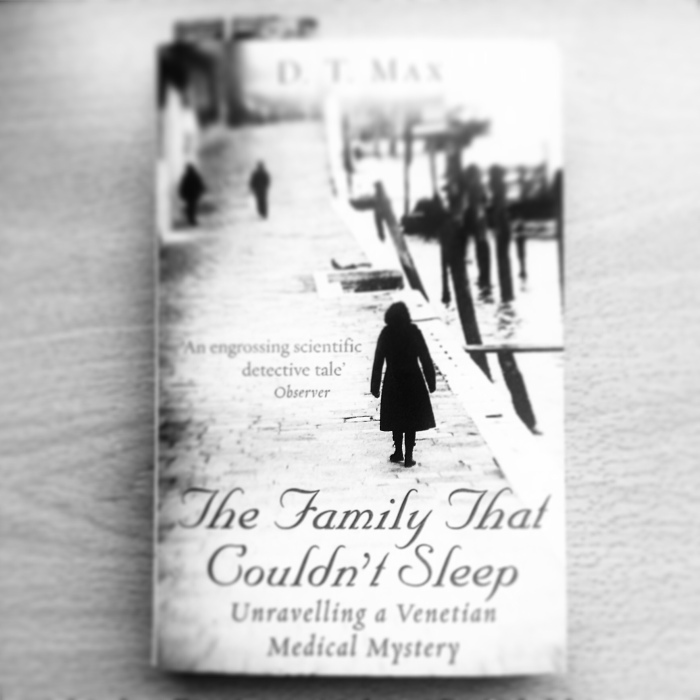
From 2006, here’s a fascinating account of a tragic Italian family. For centuries, the members have suffered from a deadly and rare illness: fatal familial insomnia (FFI).
The cause of it isn’t a virus. It’s a prion disease—a protein that causes normal brain proteins to fold abnormally.
And the result is a bizarre, nightmarish descent into sleepness nights, anxiety, sweat, delirium, and ultimately a demise.
The Family That Couldn’t Sleep: Unravelling a Venetian Medical Mystery
One Venetian family has been plagued by this prion since at least 1765. That’s the first account in written form.
And it’s with that story that D. T. Max (a staff writer for The New Yorker) unveils in classic investigative journalism fare.
The prion is a non-living and infectious self-reproducing pathogen. For a long time, it was hotly disputed in the medical world.
That’s until neurologist and biochemist Stanley B. Prusiner was able to confirm its existence in the 1980s, a discovery that won him a Nobel Prize in 1997.
Prions are responsible for the likes of mad cow disease (BSE), scrapie (a fatal issue for sheep), and Creutzfeldt-Jakob disease.
As with coronavirus, much of these issues were created by human activity. Agricultural practices and poor hygiene leading to species swapping ailments. As D. T. Max puts it:
“Prions sit at the intersection of humans’ ambition and nature’s unpredictability and it is hard to say which is more dangerous.”
Ultimately, FFI is a genetic degenerative brain disorder. But it presents itself in bizarre fashion—the lucidity of sufferers is one of the most striking parts of FFI.
Mild insomnia is one of the first symptoms. But it then gradually deteriorates into a total inability to sleep or function.
The prion assaults the brain causing atrophy of the frontal cortex and of the thalamus (a large chunk of gray matter in the brain).
For the sufferer, as the condition worsens over months, this leads to hallucinations, crippling anxiety, fits of microsleep, lucid dreams, and a general removal from society.
Of course, it’s not really possible to function in society as the condition worsens. Doing a job, for example, becomes nearly impossible.
Although in one documented case from 2001, an unnamed man went into FFI with a plan of action.
His approach included taking vitamins, meditating, using hypnosis, and indulging in sensory deprivation. All to try and get to sleep at night to remain alert during the day.
It worked to some extent, as he was able to write a book during his battle. And he, apparently, travelled extensively. But then succumbed to FFI.
And that’s one of the most disturbing things about it. How families with FFI know that it could strike at any time, but usually from the early 30s onward.
More About Silvano’s Sleepless Case
The Family That Couldn’t Sleep is along the lines of Awakenings. Or another of neurologist Oliver Sacks’ works—The Man Who Mistook His Wife for a Hat.
And we also refer to Roy Porter’s excellent Blood & Guts: A Brief History of Medicine.
All three document confounding medical mysteries that leave victims psychologically and physically destroyed. And for which there seems to be no real reason.
The Venetian story is an eerie, unsettling book we first read about in 2006 in a Guardian review. We didn’t end up buying it, but the story stuck with us over the years.
And then we bought it on impulse in February 2020. Which, by happenstance, was apt for what’s now happening in the world.
Why the impulsivity? Well, it’s difficult to forget the account of one Silvano (other than his first name, no other details about the Italian man have ever been released).
Throughout his life, he was aware fatal insomnia was in his family.
Once symptoms started in 1983, he presented himself to doctors. He was recorded until his death—his brain was submitted to science (there’s still no cure for FFI).
Neurologist Dr. Ignazio Roiter documented the man’s struggle.
At one point, Dr. Roiter ran a long electroencephalograph on Silvano—to record electrical activity in his brain.
Half an hour of it was ordered, when it’s normally supposed to be a momentary snapshot. This eventually totalled 30 feet of paper:
“What [Dr. Ignazio] saw was unprecedented. Silvano’s brain waves went up and down in a fast, jagged pattern that did not correspond to either sleep or wakefulness and that did not exist in the medical literature. He was living in some sort of in-between world.”
This entire account, documented in the book, is disturbing.
Silvano was upbeat and cheerful, chatting to staff and joking about his predicament—gallows humour.
He often took to propping himself up in a bed and reading between bouts of fitful insomnia, exhaustion, hallucinations, delerium, and microsleep.
There’s a four-stage process to FFI and the medical team documented all of them. With Silvano well aware he was doomed throughout the whole ordeal.
Inevitably, in its closing stages, FFI leads to a hollow-eyed stare. Like a shell shocked soldier staring for 1,000 yards.
“The perverse pathology of fatal familial insomnia, as his family’s disease would come to be called, moves the imagination, even of scientists. Pierluigi Gambetti, the co-discoverer of FFI, says that the Italian family reminds him of the sleepless townspeople of Macondo, frozen in their ‘state of hallucinated lucidity,’ in Gabriel Garcia Marquez’s One Hundred Years of Solitude.”
However, D. T. Max was reminded more of Edgar Allan Poe. Where the boundary between consciousness, sleep, and death is blurred “menacingly.”
He refers to Poe’s Facts in the Case of M. Valdemar to support that—a story where a doctor deals with a patient with no vital signs, but can make the individual react through hypnosis.
D. T. Max is the man who guides us through this alarming world. It’s a tour through prion epidemiology.
And how the prion, essentially, causes a biochemical collapse of your brain. Which he all documents in this fascinating, if macabre, medical detective tale.
We did wonder whether to run this review today. In amongst all the global carnage, we’re aiming to remain a source of uplifting content.
But we also don’t like to shy away from reality. We believe it’s important to confront issues facing humanity, rather than allowing complacency to become the natural order.

My two cents: I like your content too be as varied as it has always been, even if the moment is tragic almost everywhere. I found this post really interesting!
LikeLiked by 1 person
Thanking you kindly!
LikeLiked by 1 person